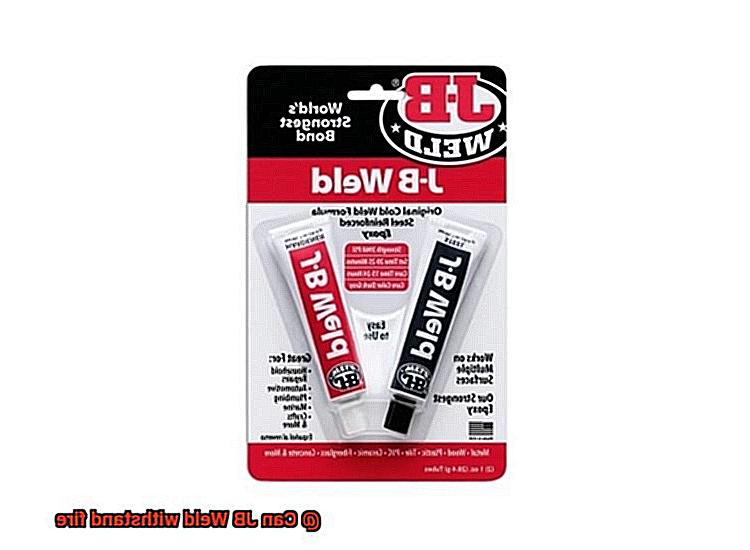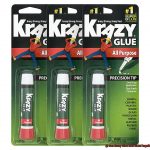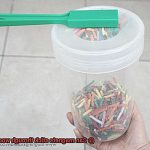Picture this: you’re in a sticky situation, desperately searching for a solution to fix something that might just go up in flames.
Enter JB Weld, the superhero of adhesives, renowned for its Herculean strength and adaptability. But here’s the burning question: can this mighty adhesive withstand the scorching heat of fire?
Buckle up, folks, because we’re about to embark on an adventure into the fiery realm of JB Weld. Get ready to unravel the science behind this miraculous glue, hear tales from those who’ve put it to the test, and discover whether JB Weld truly stands strong against the flames.
If you’re itching to know if JB Weld can handle the heat, stick around—prepare to be blown away by what this incredible adhesive can endure.
What Is JB Weld?
Contents
- 1 What Is JB Weld?
- 2 What is JB Weld Made Of?
- 3 Is JB Weld Fireproof or Fire-resistant?
- 4 How Does JB Weld React to Fire?
- 5 Can JB Weld Withstand Heat?
- 6 What Temperature Will JB Weld Fail Under Fire?
- 7 Alternatives to Using JB Weld in High-Temperature Applications
- 8 Can JB Weld Be Used in Indirect Heat Situations?
- 9 Conclusion
This incredibly popular epoxy adhesive is known for its unparalleled bonding capabilities and versatility. However, when it comes to fire resistance, there are certain properties and limitations of JB Weld that deserve our attention. In this article, we will explore the ins and outs of JB Weld’s fire resistance, providing you with the knowledge you need. Let’s dive in.
Properties of JB Weld:
At its core, JB Weld is a two-component epoxy adhesive comprising a resin and a hardener. When these two components are mixed together, they trigger a chemical reaction, resulting in an incredibly strong bond. This resilient material can withstand various stresses and strains, allowing it to excel across a wide range of applications.
Limitations in Fire Resistance:
While JB Weld can handle moderate levels of heat, it does have its limits when it comes to fire resistance. Prolonged exposure to high temperatures can cause the epoxy to soften or break down. It is important to remember that JB Weld is not designed to be fireproof or heat resistant in extreme conditions.
Enhancing Fire Resistance:
To enhance the fire resistance of JB Weld in specific applications, there are steps that can be taken. Utilizing a high-temperature resistant variant of JB Weld or applying additional layers of the epoxy can improve its performance under fire-related circumstances. However, it is vital to consult the manufacturer’s guidelines for specific recommendations regarding the use of JB Weld in high-temperature or fire-prone environments.
Considerations for Usage:
When deciding whether to employ JB Weld in a project involving fire or high temperatures, it is crucial to carefully consider the requirements and potential risks involved. If your application entails direct exposure to flames or extreme heat, it is advisable to explore specialized adhesives or materials specifically formulated for these conditions.
Conclusion:
JB Weld is undoubtedly a reliable adhesive, renowned for its exceptional bonding capabilities. However, it is important to understand the limitations of its fire resistance. While it can withstand moderate heat, prolonged exposure to high temperatures can compromise its structural integrity. Therefore, if fire resistance is a concern, it is crucial to choose an appropriate adhesive specifically formulated for high-temperature applications.
What is JB Weld Made Of?
Its exceptional strength and versatility make it a go-to adhesive for many. So, what exactly is JB Weld made of? Let’s explore its key components and delve into the world of this remarkable adhesive.
JB Weld consists of two main components: a resin and a hardener. The resin component is typically made from bisphenol-A (BPA) epoxy resin. This type of resin is widely known for its outstanding strength and durability, making it an ideal choice for bonding materials together. When combined with a hardener, the BPA epoxy resin undergoes a chemical reaction and cures into a solid state. It is during this curing process that JB Weld develops its incredible strength and heat resistance.
The hardener component of JB Weld is usually composed of polyamine compounds. These compounds act as catalysts for the curing process, initiating the chemical reaction with the epoxy resin. While different formulations of the hardener may be used depending on the intended use of the JB Weld product, they all work harmoniously with the epoxy resin to create a strong bond.
In addition to these primary components, JB Weld may also contain various additives and fillers that enhance its properties. These additives can include substances such as fiberglass, ceramic, or metal powders, which contribute to the adhesive’s strength and other desired characteristics. For example, fiberglass can increase the adhesive’s overall strength, while ceramic or metal powders can enhance thermal conductivity or resistance to chemicals.
Despite its excellent heat resistance, it is important to note that JB Weld does have limitations when it comes to fire exposure. Prolonged exposure to high temperatures can cause JB Weld to soften or break down. Therefore, for projects involving fire or extreme heat, it is advisable to consider specialized adhesives that are specifically designed for those conditions.
To summarize, JB Weld is primarily composed of a resin component, typically made from bisphenol-A epoxy resin, and a hardener component, usually consisting of polyamine compounds. These components, combined with various additives and fillers, create a robust and versatile adhesive. While JB Weld is known for its heat resistance, it is essential to consult the manufacturer’s guidelines to determine its suitability for high-temperature applications.
Is JB Weld Fireproof or Fire-resistant?

When it comes to adhesive superheroes, JB Weld reigns supreme. But can this mighty adhesive withstand the searing heat of a blazing fire? In this blog post, we will delve into the depths of JB Weld’s properties and explore whether it possesses the superpower of fireproofing or fire resistance. So strap on your safety goggles and prepare for a fiery adventure.
Understanding the Difference:
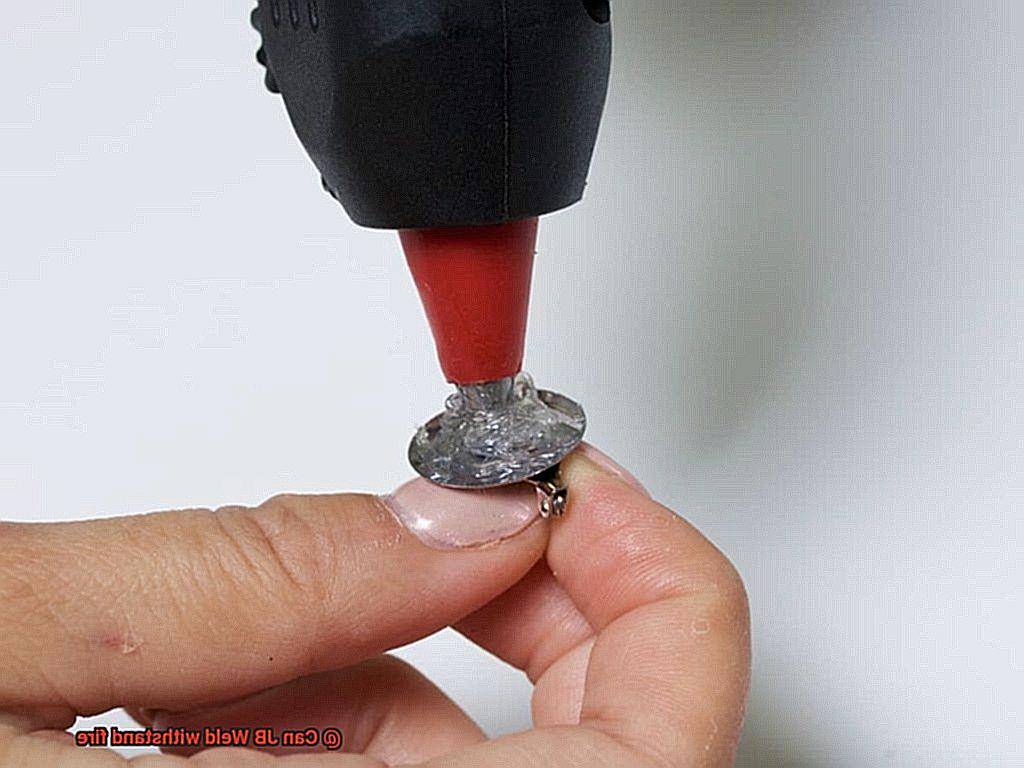
Before we embark on our quest to uncover JB Weld’s fireproof or fire-resistant capabilities, let us first clarify the distinction between these two terms. Fireproof materials are impervious to catching fire, while fire-resistant materials are designed to endure exposure to flames without igniting or spreading the inferno.
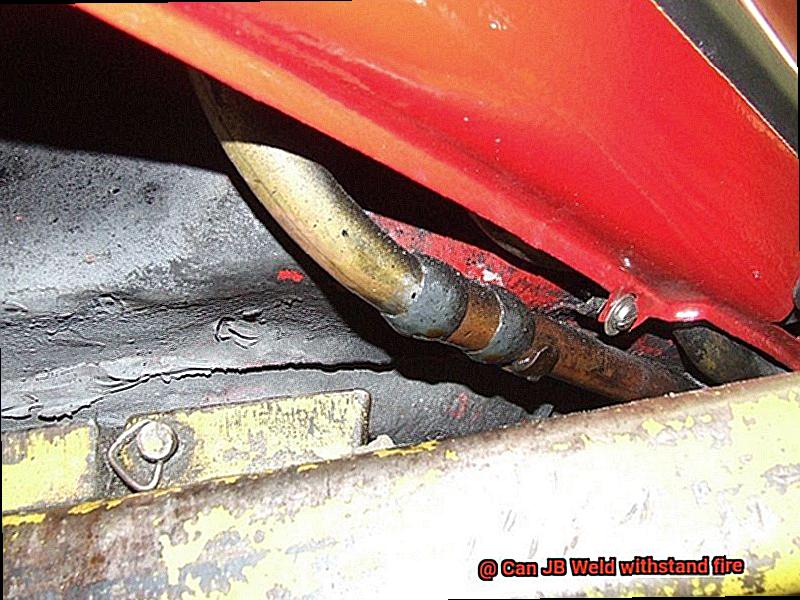
JB Weld’s Fire Resistance:
Now, let us turn our attention to the main event. JB Weld falls into the realm of fire-resistant materials. While it may not possess an impenetrable shield against flames, it does possess the remarkable ability to resist them and withstand high temperatures to a certain extent. Brace yourself for this revelation: JB Weld can typically endure temperatures up to a scorching 550 degrees Fahrenheit (287 degrees Celsius) without compromising its integrity or strength.
Limitations and Precautions:
However, even the mightiest warriors have their limits. Prolonged exposure to extreme heat can cause JB Weld’s epoxy composition to deteriorate, resulting in a loss of its adhesive prowess. Consequently, it is crucial to adhere to JB Weld’s recommended temperature range when utilizing its abilities.
Enhancing Fire Resistance:

To unleash JB Weld’s true fire-fighting potential, there are a few additional precautions you can take. Applying a protective layer of heat-resistant paint or coating over the cured JB Weld acts as an extra barrier against the scorching flames. Proper ventilation and steering clear of direct contact with open fires are also essential safety measures that can bolster JB Weld’s fire resistance.
Conclusion:
In summary, while JB Weld may not possess an impenetrable force field against fire, it most certainly exhibits fire-resistant qualities within a specific temperature range. Its ability to withstand temperatures up to a blistering 550 degrees Fahrenheit makes it a formidable companion in applications where heat or flames may be present. However, always remember to adhere to JB Weld’s recommended temperature range and exercise additional caution when operating in scorching environments.
How Does JB Weld React to Fire?
In this article, we’ll delve into the subject, providing you with the knowledge necessary to make informed decisions about using JB Weld in high-temperature environments.
JB Weld’s Heat Tolerance:
While JB Weld boasts impressive durability, it is not specifically designed for direct exposure to flames or extreme temperatures. It can withstand moderate heat of up to 550 degrees Fahrenheit, making it suitable for many applications. However, prolonged exposure to high temperatures may cause the adhesive to soften or even melt, compromising its overall strength.
Effects of Fire on JB Weld:
When faced with fire, JB Weld undergoes changes in physical properties. The adhesive becomes more pliable or may melt at elevated temperatures, which can impact its bonding effectiveness. This crucial information should be taken into account when working on projects where fire resistance is essential.
Filler Materials and Fire Resistance:
Different variations of JB Weld contain various fillers like metal powders or glass fibers, which react differently to heat. Some of these fillers provide enhanced fire resistance compared to others. However, it’s important to note that while fillers may improve fire resistance, the adhesive itself is not specifically engineered for high-temperature applications.
Specialized Adhesives for Fire Resistance:
If your project demands fire resistance, exploring adhesives designed explicitly for such applications is highly recommended. These specialized adhesives are formulated with additives and fillers that enhance their ability to withstand high temperatures and flames.
Can JB Weld Withstand Heat?
When it comes to tackling tough repairs or DIY projects, JB Weld has earned a reputation for its strength and durability. However, if you’re wondering whether JB Weld can withstand high temperatures or exposure to fire, it’s essential to understand the adhesive’s limitations. In this article, we’ll delve into the world of JB Weld’s heat resistance, explore the factors that affect its performance, and discuss alternative options for applications requiring higher heat resistance.
Understanding JB Weld’s Heat Resistance:
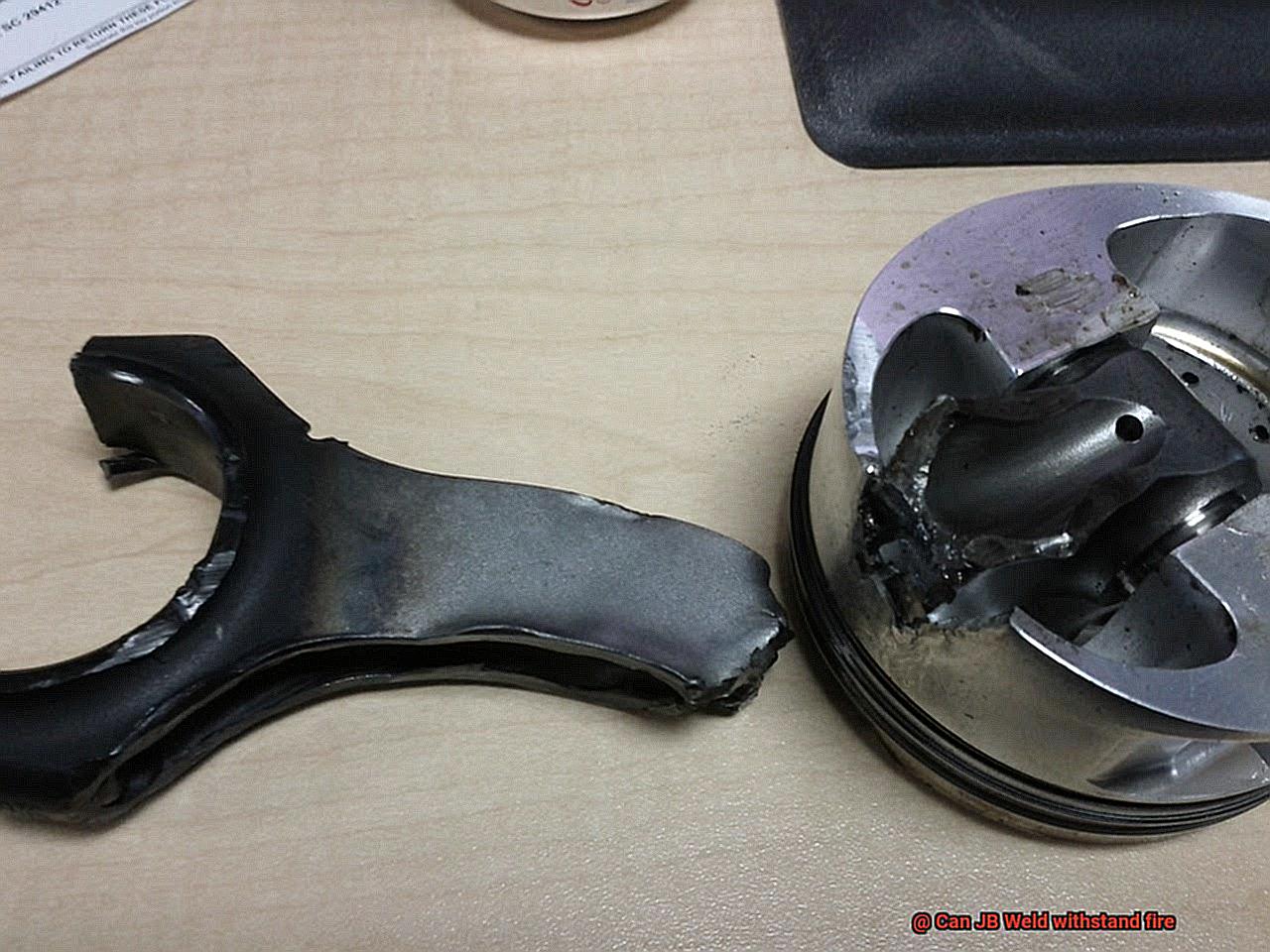
JB Weld is composed of a resin and a hardener that, when mixed together, create a powerful bond. While JB Weld is known for its robustness, its heat resistance can vary depending on the product variant. In general, most JB Weld products have a maximum temperature resistance of around 600 degrees Fahrenheit (315 degrees Celsius) once fully cured. This makes it suitable for many household applications and automotive repairs where normal operating conditions generate moderate heat.
Factors Affecting JB Weld’s Heat Resistance:
Prolonged exposure to high temperatures or rapid temperature changes can weaken the bond created by JB Weld. Constantly subjecting the adhesive to extreme heat may cause it to degrade over time, resulting in a loss of strength and potential bond failure. It is crucial to follow the manufacturer’s instructions and consider alternative options for applications that require sustained or intense heat resistance.
Alternative Options for High Heat Applications:
For projects demanding higher heat resistance than what JB Weld can provide, specialized high-temperature epoxy adhesives are available in the market. These adhesives are formulated to maintain their strength and stability even at temperatures exceeding 1000 degrees Fahrenheit (538 degrees Celsius). They are specifically designed to withstand extreme heat and are an excellent choice for applications involving fireplaces, exhaust systems, or industrial machinery.
Conclusion:
While JB Weld is an excellent adhesive with impressive strength and durability, its heat resistance is limited to temperatures below 600 degrees Fahrenheit (315 degrees Celsius). It can handle normal household heat conditions, but prolonged exposure to high temperatures or rapid temperature changes may compromise its bond strength. For applications requiring higher heat resistance, exploring specialized high-temperature epoxy adhesives is recommended. Remember to consult the manufacturer’s instructions and choose the right adhesive for your specific needs.
What Temperature Will JB Weld Fail Under Fire?
JB Weld, the go-to adhesive for bonding, sealing, and repairing, is about to face the heat. So, how hot can it handle? Buckle up and prepare for a fiery exploration.
Let’s get one thing straight right off the bat: JB Weld is not a fire-resistant superhero. While it’s a fantastic adhesive, its ability to withstand high temperatures or fire is somewhat limited. Don’t expect miracles, folks.
Now, the temperature at which JB Weld will wave the white flag can vary based on a few factors. One of them is the specific formulation you’re using. Different types of JB Weld have different heat resistance properties – it’s like having a whole squad of adhesive Avengers. To find out the exact temperature limit, consult your product’s mission manual, aka the manufacturer’s instructions.
In general, JB Weld can take the heat up to around 500 degrees Fahrenheit (260 degrees Celsius). That’s no small feat. But hold on tight – that limit is for short bursts of flame, not a continuous dance with fire. If you plan on exposing JB Weld to high temperatures for an extended period, its performance might weaken faster than Superman under a kryptonite shower.
Remember that JB Weld doesn’t fight this battle alone. External factors like the surrounding environment and the materials it’s bonding play a crucial role in determining its fate. If those materials have a low heat resistance themselves, it’s like sending JB Weld into an inferno without a shield – failure is inevitable.
To wrap up this fiery tale, JB Weld isn’t invincible when it comes to fire. It can handle temperatures up to 500 degrees Fahrenheit for short periods, but don’t push your luck with prolonged exposure or continuous high temperatures – it might just crumble under pressure. Follow the guidance of your adhesive commander (aka the manufacturer) and consider the specific formulation you’re working with.
Alternatives to Using JB Weld in High-Temperature Applications
When it comes to high-temperature applications, JB Weld may not be the best option for bonding materials together. But fear not, because there are alternatives that can handle the heat like a pro.
One alternative is specialized heat-resistant adhesives. These adhesives are specifically designed to withstand extreme temperatures while maintaining their strength and integrity. Imagine a superhero that can handle temperatures up to 2000 degrees Fahrenheit – that’s what you get with ceramic-based heat-resistant adhesives. They are commonly used in industries like aerospace and automotive, where high temperatures are just part of the job.
If you’re looking for something with a metallic touch, metal-based adhesives are here to save the day. These adhesives are formulated with metallic fillers that give them excellent heat resistance, making them perfect for bonding metal components in engines and exhaust systems. They can handle temperatures up to 500 degrees Fahrenheit or even higher.
But wait, there’s more. Sometimes, mechanical fasteners like bolts, screws, and clamps can be your best bet in high-temperature applications. These trusty companions provide a secure connection that can withstand the stress and temperature fluctuations associated with extreme heat.
Now, before you rush to make your decision, there are a few factors to consider. First, think about the temperature range you’ll be dealing with. Different adhesives have different limits, so make sure you choose one that can handle the heat you’ll be throwing at it. Second, consider material compatibility. Some adhesives work better with certain materials than others, so check if your adhesive of choice plays well with your materials. And lastly, strength requirements – think about how much force your bond will need to withstand.
Can JB Weld Be Used in Indirect Heat Situations?
When it comes to heat resistance, JB Weld is designed to handle high temperatures. The manufacturer claims that once fully cured, it can withstand continuous temperatures of up to 500 degrees Fahrenheit (260 degrees Celsius). This makes it a suitable option for applications where there is a moderate amount of heat present, such as near engines, exhaust systems, or heating elements.
However, it’s important to note that the heat resistance of JB Weld may vary depending on the specific product variant. Some variants are specially formulated for high-temperature applications, while others may have lower heat resistance. So, before using JB Weld in indirect heat situations, be sure to check the specifications and recommendations provided by the manufacturer.
To ensure optimal performance in indirect heat situations, proper surface preparation and application techniques are crucial. Cleaning and roughening the surfaces to be bonded will improve adhesion. Following the manufacturer’s instructions regarding curing time and temperature is also essential.
In some cases, you may need to take additional measures to enhance the heat resistance of JB Weld. Applying multiple layers of the adhesive or using it in conjunction with other heat-resistant materials can provide added protection.
However, it’s worth noting that while JB Weld can withstand high temperatures, it may not be suitable for applications where it will be exposed to direct flames or extremely high temperatures for prolonged periods. In such cases, specialized fire-resistant adhesives or materials should be used instead.
Nr8xR9DmE_g” >
Conclusion
In conclusion, JB Weld is renowned for its exceptional bonding capabilities, making it a powerful adhesive in various applications. However, when it comes to facing the fiery inferno, there are certain constraints to bear in mind. While JB Weld can withstand moderate levels of heat, subjecting it to prolonged exposure under scorching temperatures can cause the epoxy to soften or crumble. It’s crucial to recognize that JB Weld isn’t engineered to be fireproof or impervious to extreme conditions.
To bolster the fire resistance of JB Weld in specific scenarios, there are measures that can be taken. Opting for a high-temperature resistant variant of JB Weld or applying additional layers of this tenacious epoxy can elevate its performance when confronted with flames and infernos. Nonetheless, it’s imperative to consult the manufacturer’s guidelines for precise recommendations on utilizing JB Weld in environments prone to high temperatures or fire hazards.
When deliberating whether JB Weld is suitable for projects involving fire or intense heat, meticulous consideration of requirements and potential risks is paramount. If your application necessitates direct exposure to flames or blistering temperatures, exploring specialized adhesives or materials specifically formulated for these arduous conditions would be advisable.
In summary, while JB Weld unquestionably possesses remarkable adhesive properties, its capacity for fire resistance does have limitations.

